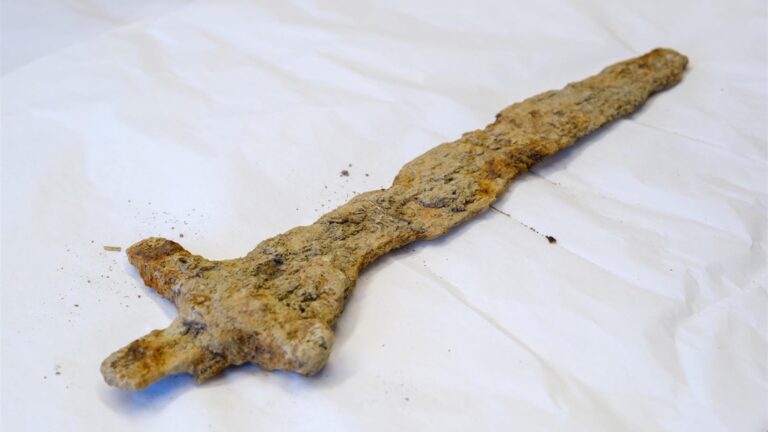A farmer in Norway's Rogaland county found the clay-encrusted remains of the Viking Age weapon while clearing a field. Here’s the fascinating story.
County archaeologists have confirmed that it is the remains of an iron sword from the Viking Age. Inscriptions reveal the ancient weapon seems to be a rare type of iron sword made in the Frankish Empire.

The Viking Age (793–1066 AD) was marked by seafarers exploring, trading, and raiding from Scandinavia across Europe. Known for longships and fierce warriors, Vikings impacted medieval society, established settlements, and influenced cultural exchange.
The Discovery on a Farm
“We were about to start sowing grass on a field that has not been plowed for many years,” Øyvind Tveitane Lovra, who found the weapon in Suldal, said in a Rogaland county statement.
The farmer began to clear the field, stumbling upon a piece of old iron. His first thought was to throw it away, before he realised what it could be. He contacted the County archaeologists, which Norwegian law requires.

“This is very rare,” said Rogaland archaeologist Lars Søgaard Sørensen. “The sword was the greatest status symbol in the Viking Age, and it was a privilege to be allowed to wear a sword.”
The Viking Age Sword
The sword is 37 centimetres long, and about half of its length is missing. It is nevertheless surprisingly well-preserved, despite the Rogaland region having poorer preservation conditions for swords compared with other parts of the country.
“That the sword has been lying in dense clay is why it is so well-preserved,” explained Lars Søgaard Sørensen in a statement.
Fascinating Inscriptions
X-rays show the outlines of inscriptions with cross patterns and possibly letters on the blade.

“This means it could be a so-called VLFBERHT sword from the Viking Age or early Middle Ages. These are high-quality swords produced in the Frankish Empire (now Germany) marked with the weapon manufacturer's name,” explains Sigmund Oehrl, professor of archaeology at the University of Stavanger.
“When we first saw the sword, we were happy because it's not often we get swords from the Viking Age. When we saw the X-ray image, we were really excited. We did not expect there to be an inscription on the blade,” says Oehrl enthusiastically.
The inscriptions the professor refers to suggest that the find is more special than it first appeared.
“As far as we know, about three to four thousand swords from the Viking Age have been found in Europe. The number of swords with these inscriptions, like the one found at Lovra, is only around 170. In Norway, around 45 such swords have been found. We are not aware of any similar swords being found in Rogaland before,” said Oehrl.

Next Steps
Archaeologist Lars Søgaard Sørensen and his colleague Kim Thunheim have conducted investigations on Øyvind Tveitane Lovra's farm following the rare sword find. They have not found any other artefacts in the area.
The sword has a lot of rust and must be conserved and further examined before they can date it more precisely and better explain what the inscriptions mean. At present, the team believes the sword was likely produced between the years 900 and 1050.
“There has been a concentration of sensational finds in recent years, including last year's gold find and the recent relic chest in the Cathedral,” said conservator Hege Hollund from the Archaeological Museum in Stavanger.

